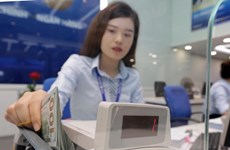Closing spurt lifts VN-Index
Significant buys in the final minutes
of February 26’s session on the Ho Chi Minh Stock Exchange helped the
VN-Index manage a gain of 0.39 percent on the day to close at 496.91
points.
Significant buys in the final minutes
of February 26’s session on the Ho Chi Minh Stock Exchange helped the
VN-Index manage a gain of 0.39 percent on the day to close at 496.91
points.
Trading value and volume began to suggest a recovery from the doldrums surrounding the Tet (lunar New Year) holiday, with activity totalling 1.5 trillion VND (78.9 million USD) on a volume of 34.9 million shares.
The announcement by the Ministry of Finance on Feb. 26 that electricity rates would rise 6.8 percent on March 1 helped make Vinh Son-Song Huynh Hydro-power (VSH) the most-active share, with 2.3 million traded during the session.
“When electricity rates go up, power plants will benefit, and it would be lucrative to start investing in them now,” said Nguyen Thanh Huyen, an investor with VPBank Securities Co.
On the Hanoi Stock Exchange, the HNX-Index closed largely unchanged at 162.43, while the value of trades remained modest at 438.3 billion VND (23 million USD) on a volume of 13.9 million shares.
Kim Long Securities Co (KLS) continued as the most active share on the northern bourse, with 2.3 million changing hands.
Johan Kruimer, an analyst at the Ho Chi Minh Stock Exchange, said that equity prices seemed to be holding up quite well despite the reigning uncertainty, and that for the moment it seemed that the downside risk was fairly limited.
“We mights be facing a period of a couple of weeks which will be characterized by relatively low volatility and consolidating prices,” he said, noting that the most likely scenario still called for higher prices as soon as the investment community saw “some light at the end of the consolidation tunnel”.
Woori CBV Securities Co’s research team concurred that a steep correction was unlikely thanks to the steady improvement in trading volume and a repeated appearance of high demand for shares for at least 15 minutes during each session, helping erase other losses on the day.
Concerns remained among investors over the rising costs facing domestic businesses, including a rumour that the central bank might lift the cap on lending interest rates, currently holding them at no more than 150 percent of the prime rate./.
Trading value and volume began to suggest a recovery from the doldrums surrounding the Tet (lunar New Year) holiday, with activity totalling 1.5 trillion VND (78.9 million USD) on a volume of 34.9 million shares.
The announcement by the Ministry of Finance on Feb. 26 that electricity rates would rise 6.8 percent on March 1 helped make Vinh Son-Song Huynh Hydro-power (VSH) the most-active share, with 2.3 million traded during the session.
“When electricity rates go up, power plants will benefit, and it would be lucrative to start investing in them now,” said Nguyen Thanh Huyen, an investor with VPBank Securities Co.
On the Hanoi Stock Exchange, the HNX-Index closed largely unchanged at 162.43, while the value of trades remained modest at 438.3 billion VND (23 million USD) on a volume of 13.9 million shares.
Kim Long Securities Co (KLS) continued as the most active share on the northern bourse, with 2.3 million changing hands.
Johan Kruimer, an analyst at the Ho Chi Minh Stock Exchange, said that equity prices seemed to be holding up quite well despite the reigning uncertainty, and that for the moment it seemed that the downside risk was fairly limited.
“We mights be facing a period of a couple of weeks which will be characterized by relatively low volatility and consolidating prices,” he said, noting that the most likely scenario still called for higher prices as soon as the investment community saw “some light at the end of the consolidation tunnel”.
Woori CBV Securities Co’s research team concurred that a steep correction was unlikely thanks to the steady improvement in trading volume and a repeated appearance of high demand for shares for at least 15 minutes during each session, helping erase other losses on the day.
Concerns remained among investors over the rising costs facing domestic businesses, including a rumour that the central bank might lift the cap on lending interest rates, currently holding them at no more than 150 percent of the prime rate./.













